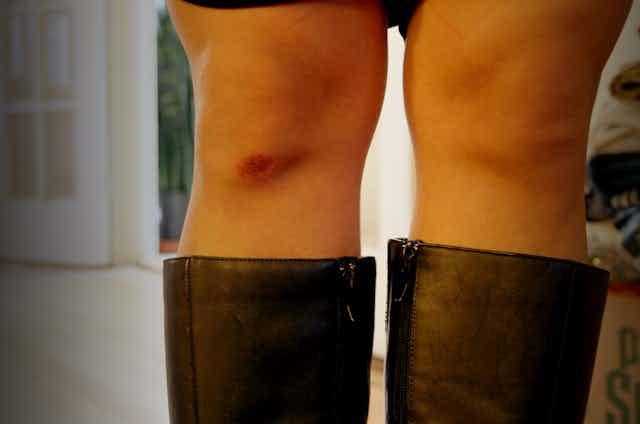Dry scalp? Blocked ears? Crusted eyes? Our bodies produce many different unusual, sometimes repellent secretions, and their function doesn’t always seem entirely clear. But each has their own important role, which often goes unappreciated.
Flaky or dry scalp is an extremely common condition, but in severe cases it certainly doesn’t feel trivial. Put aside notions that it’s a factor of poor hygiene – the underlying cause is not completely clear, but it may be exacerbated by hair care regimes which dry or irritate the scalp. What is known is that flakes of dandruff are comprised of cell complexes, arising from sloughed off skin.
The outermost layer of the skin (the epidermis) is comprised in part of dead cells, that act as an essential protective barrier. Dead cells shed more easily, and will be replaced with new ones as skin constantly regenerates and grows. If this happens at too great a rate, the result is dandruff.
The first measure is to try an over the counter anti-dandruff shampoo. These contain antifungal and anti-inflammatory compounds both understood to have dandruff healing properties since fungi and inflammation are believed to be potential factors in the development of a crusty scalp. These compounds – selenium and coal tar for instance – can also help relieve the symptoms of itch which may often prove worse than the flaking.
It’s worthwhile trialling a different formula if the first doesn’t work. Certain conditions like psoriasis and eczema can also be the underlying cause, and may require alternative treatment.
Scabs may be unsightly – but they function beautifully
Scabs are the body’s natural response to being wounded. Cuts, punctures or breaks in the skin open up blood vessels to the atmosphere around us. In response, the bloodstream recruits its clotting agents – the platelets – to help plug the gap. Platelets bring blood cells together to form a clot, creating a bung to stop bleeding, and prevent bacteria shifting from the skin into the circulation, where they can do more damage. When the clot dries out, a scab is formed.
Scabs can look horrible, but don’t worry – they’re meant to. Sometimes pus forms which can give scabs a yellow rather than reddish-brown colour, and might suggest that an infection is brewing. Redness of the uninjured skin around and tracking away from the scab is another telltale sign of possible infection too.
Resist the temptation to pick off a scab from the skin, no matter how tempting it may seem. They may be unsightly, or itchy, but they’re performing the job they’re supposed to – keeping out bugs and allowing wounds to heal. Take good care of them instead, by keeping them untouched and clean, and wait for them to shed themselves.
The eyes have it
Sleep sand. Eye bogies. Doze dust. The debris we find in the corners of our eyes each morning goes by many different names. Few of us know exactly what it is, why it’s there, or its scientific name, rheum.
Tears lubricate the exposed surface of the eyes, stopping them from getting dry and sore. They also hose away grit and dust and have natural antibacterial properties to fight infections.
But our eyes make more than just tears. The lids have many little glands which discharge natural oily substances allowing tears to spread evenly across the eye and prevent them evaporating away. In addition, mucus-secreting glands, much like those in the nose that make snot, make a thin mucus which also helps to trap and eliminate rogue particles.
In large amounts, oil and mucus can irritate the eyes, but normally get swept away by tears and blinking during the day. By night, our eyes remain shut and rheum builds up. Whether they take on the appearance of sticky bogies or crusts depends on how dry they get overnight, and may be proportional to how long you sleep.
(Ear) waxing lyrical
Ear wax is a largely invisible entity – more often felt than seen. Notice a feeling of blocked or congested ears, or a smothered sense of hearing, and the wax in your ears might be becoming problematic.
It also has a clinical name – cerumen. In part, it’s made of oils and sweat from glands lining the ear canal. The majority of ear wax though is keratin, the natural protein that toughens skin, hair and nails. This is because the ear canal is lined with skin, all the way up to the ear drum. In mixing with the secretions, shed skin produces a waxy substance ranging in colours across the brown spectrum.
Fresh, healthy earwax tends to be yellow to honey-brown in colour, whereas older, thicker earwax becomes darker brown, sometimes even black. Notice red or green staining, then blood or bacteria may be mixing with the wax. Among other diagnoses, this raises the possibility of an ear infection, especially if there’s also a runny or foul-smelling discharge.
Like many of the other bodily secretions, cerumen also traps debris and other nasties (even insects) that could irritate or damage the delicate ear drum. But problems arise if the wax builds up or hardens too much, blocking conduction of sound to the drum, and dampening your hearing.
Nothing smaller than an index finger (with well-trimmed nails) should ever go in your ear canal. Stop cleaning with cotton buds too. All this does is compress cerumen into little impacted cakes. Instead, medicinal olive oil from the pharmacy can help soften it down, making it easier for the ear to clear it naturally.
Blood, sweat and tears – and wax, skin and mucus – can cause many commonplace issues. But look beyond these minor ailments and be grateful that they’re there. You’d be sorry if they weren’t.

